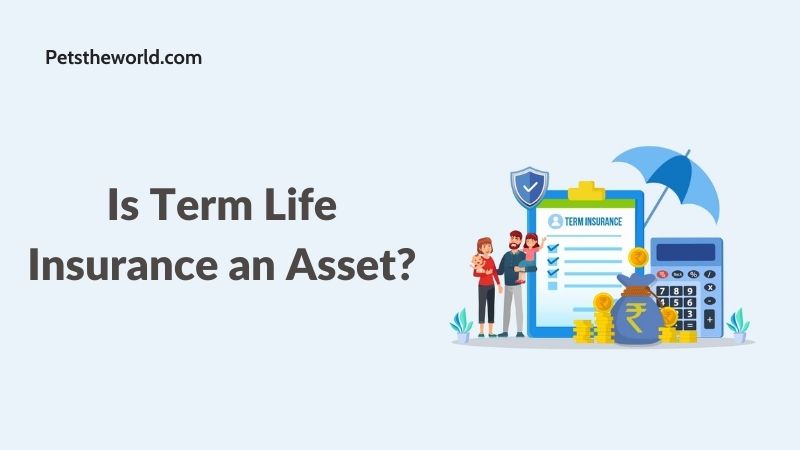In the realm of personal finance, the notion of assets serves as a cornerstone for wealth management and strategic planning. Assets are the economic resources that hold value and contribute to an individual’s net worth. They range from tangible possessions like real estate and vehicles to intangible holdings such as stocks and bonds. However, nestled within the landscape of financial instruments lies a question that often stirs debate: Is term life insurance an asset?
The inquiry into term life insurance‘s asset status is multifaceted and warrants a nuanced exploration. While conventional wisdom may suggest that assets are items of value that appreciate over time, the classification of term life insurance presents a unique conundrum. Let Petstheworld delve deeper into this discussion to decipher whether term life insurance truly qualifies as an asset.
Defining Term Life Insurance:
Before delving into its asset status, it’s imperative to grasp the essence of term life insurance. Term life insurance is a form of financial protection that provides a death benefit to beneficiaries if the insured individual passes away during the policy’s specified term. Unlike permanent life insurance, which encompasses features like cash value accumulation, term life insurance operates on a straightforward premise: paying premiums in exchange for a death benefit.
Is Term Life Insurance an Asset?
In the traditional sense, assets are characterized by their ability to generate income or appreciate in value over time. By this yardstick, term life insurance may not fit snugly into the mold. Nevertheless, it behooves us to explore the various dimensions through which term life insurance can be construed as an asset.
1. Cash Surrender Value:
Convertible term policies offer a unique avenue for term life insurance to expand beyond its conventional boundaries. These policies provide policyholders with the flexibility to convert their term coverage into a permanent life insurance policy, potentially unlocking a cash surrender value. This feature introduces an aspect akin to an asset into term life insurance, although its realization depends on specific policy terms and conversion provisions. By offering this option, convertible term policies cater to individuals seeking long-term financial planning and adaptability in their insurance coverage.

2. Asset Protection:
Term life insurance, although lacking intrinsic monetary value, plays a crucial role as a safety net for beneficiaries in times of financial distress. Upon the insured’s death, the death benefit provided by term life insurance acts as a vital lifeline, addressing various expenses such as mortgage payments and educational costs. In this capacity, term life insurance takes on the semblance of an intangible asset, shielding loved ones from potential economic hardships and ensuring their financial stability during challenging times. Its significance lies not only in its financial value but also in the peace of mind it affords to policyholders and their families.

3. Estate Planning Utility:
In the intricate landscape of estate planning, term life insurance stands out as a strategic instrument for enhancing financial readiness. Leveraging its death benefit, term life insurance offers a vital source of liquidity to address estate taxes, outstanding debts, and various financial responsibilities. Although term life insurance may not possess the tangible characteristics of traditional assets such as stocks or real estate, its pivotal role in fortifying estate plans grants it a unique asset-like quality. By incorporating term life insurance into their strategies, individuals can effectively safeguard their estates and ensure the seamless transfer of assets to their beneficiaries.
4. Collateralization Potential:
Furthermore, term life insurance exhibits versatility beyond its traditional role, potentially serving as collateral for loans, further solidifying its status as an asset in specific financial transactions. In such instances, lenders may accept term life insurance policies as collateral, utilizing the death benefit as a form of security against the loan. This highlights the multifaceted nature of term life insurance and underscores its potential as a valuable financial asset, especially in scenarios where collateralized borrowing is involved. By recognizing and leveraging these additional functionalities, policyholders can maximize the utility of their term life insurance policies in diverse financial contexts.

Conclusion:
In navigating the discourse surrounding term life insurance’s asset status, it becomes evident that the answer is not a binary one. Rather, term life insurance straddles the boundary between conventional assets and non-traditional holdings, embodying characteristics of both. While it may lack the income-generating capacity or appreciative trajectory of traditional assets, its utility in providing financial protection, estate planning facilitation, and collateralization renders it an asset in its own right, albeit one with distinct nuances.
In the tapestry of personal finance, term life insurance occupies a unique niche—one that transcends the conventional dichotomy of assets and liabilities. Its value lies not merely in numerical quantification but in the peace of mind it bestows upon policyholders and their beneficiaries. Thus, while the question “Is term life insurance an asset?” may evoke divergent perspectives, the underlying essence remains unchanged: term life insurance, in its myriad forms, stands as a pillar of financial stability and security in an ever-evolving landscape.
